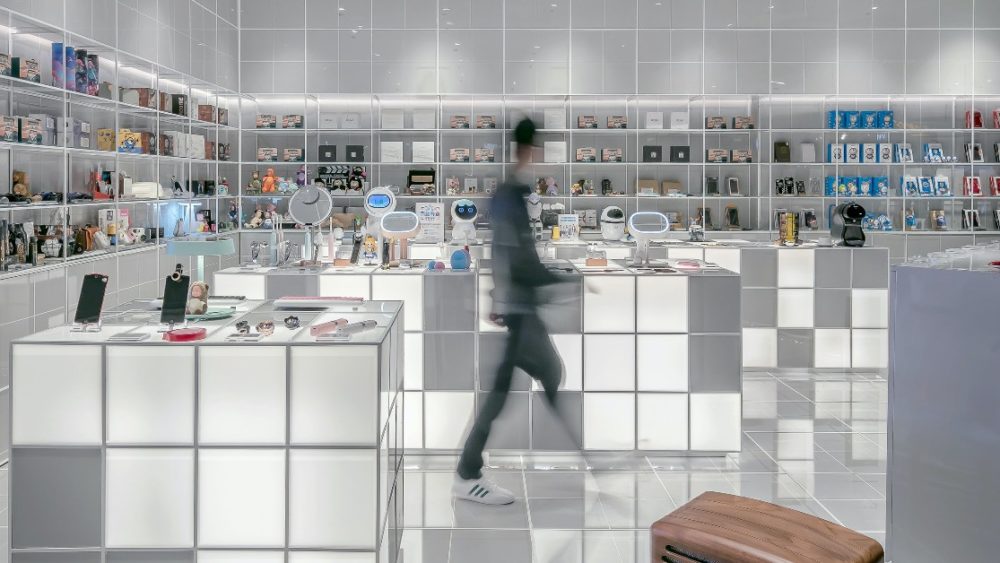What is digital POSM?
Digital point-of-sale materials means incorporating digital screens or other elements into in-store displays. There are a variety of digital displays available today, which can drive a wide range of shopper interactions. All sizes of screens can be used to make traditional print displays more interactive and engaging using principles of shopper-centered design.
This is an approach that puts the shopper’s experience at the forefront of POSM strategy. This includes product positioning, educational materials, automatic content updates and product comparison options. The level of digital integration can vary. From smart shelving product navigators and linking to live content reviews, to simple messaging displays that help brands to stand out and increase product recall.
Phygital
Digitalization of the customer experience has increased demand for a frictionless path to purchase, across channels and customer touchpoints. As such, stores are embracing technologies that bridge the gap between physical and digital retail.
Our POSM expert Ash Smith, says “from FMCG to luxury we are seeing the blurring of channels and what were traditionally a siloed functions of a retail or consumer businesses such as e-commerce or social media are requiring to become more integrated and interlinked with the other marketing functions than ever before. This integrated approach no longer just looks at the different touch points but rather giving the customer access to multiple paths to purchase at any point in their customer journey.” This has given rise to ‘phygital’, the concept of using technology to bridge physical and digital experiences.
Many people today browse across channels in what’s known as the ‘messy middle’ of the customer path-to-purchase. By incorporating digital touchpoints in physical stores, retailers can reduce the time spent in what Think with Google describes as the ‘exploration/evaluation loop’. This is a period in which customers continually compare products and evaluate the options available to them. By connecting digital POSM to other channels and platforms, it can provide reassurance to customers that this is the right product for them.
Highly connected digital POSM can include lift and learn technology to augment the customer experience. Not only does this help educate the customer, but it can also link to social posts and online reviews that will validate the purchase decision. Tag created a display for Bobbi Brown which implemented lift and learn technology for increased customer engagement and linked to influencer content that was updated daily.
For consumers who prefer to browse in-store and then commit to the purchase online, digital POSM can also drive O2O content and sales. For example, a QR code on display that links customers in-store to content online to drive sales after the individual has left the store.
This is just one strategy for using customers’ mobile devices with POSM to augment the in-store experience. This is valuable to a growing market of Gen Z consumers, 88% of whom prefer omnichannel branded experiences. We are focused on integrating online and offline shopping to work into a truly omnichannel retail journey for customers.
Stand out
Digital POSM can be a major differentiating factor in long aisles with various brands vying for attention. Even simple digital screens that display brand messaging can increase dwell time and increase brand recall. By incorporating AR technology, the shopper’s device can become a tool for them to explore your product ranges more interactively.
It can be used to provide branded experiences that drive loyalty and advocacy from the aisle. Such ambitions are traditionally reserved for concept stores and expertise labs, but in the age of convenience, marketers need to deliver the same experience across all locations and channels.
To stand out from the competition, we design fully integrated digital solutions with in-store product navigators, smart shelving, live content reviews, data tracking and links to eCommerce sites. By helping customers find exactly the right product for them, we not only save them time, but also build an authoritative navigation experience that the customer will remember for accurate recommendations. Our team saw a 35% uplift in sales over the first 6-month period compared with control stores when we introduced a digital display solution in CVS that helped consumers find the right skincare product for their needs.
Education at shelf
POSM can be used to give information, educational content and confidence to customers about their purchase decisions. Interactive digital screens can help by giving instant recommendations on the right product for them, with shelf illumination to aid navigation.
When Tag developed an updatable gondola end display for a Nivea product launch, there was a 60% uplift from the previous 6 months sales in the category. Although as marketers we are looking to increase aisle dwell time, our goal should be to aid consumers to find want they want whilst also saving them time.
In the ‘Careful Economy’ that has come out of the pandemic, customers are looking to reduce their time spent in-store and expecting less physical contact when they are there. As such, shoppers are likely to prefer a digital shop assistant to an actual one. By digitizing your POSM, you can still deliver the same level of information to shoppers in-aisle to increase conversions, whilst respecting customer health concerns. In a recent McKinsey survey, 87% of US shoppers said that they would prefer to shop unassisted in-store as a direct result of Covid-19.
Efficiency
Digital POSM solutions are fast becoming an essential part of a successful in-store strategy. Although they cost more upfront, the ability to update them instantly offers to replace temporary POSM completely. With many companies using POSM to highlight short-term promotions or new products, there is a high turnover of materials. Digitizing your POSM can provide a more sustainable but equally engaging display.
Display content can be adapted according to season, sales, campaign and more. This can be done in real-time to reflect changing environmental factors and use geolocation technology to make the content more relevant. The automation of these updates according to real-time circumstances is known as parting, and it helps to maximize content relevancy and contextualization.
New campaign content can be simply uploaded to the display using a USB stick, cutting out assembly time and increasing speed-to-market. In the fast-paced economy of today, this can be an invaluable tool for meeting consumer expectations.
Gain insights
The digitization of POSM allows data to flow in two directions – into and out of the store. Dashboard reporting can be used to track data and shopper interactions. This helps us to perform test & learn campaigns in different stores to see what is working and what is not. Combined with sales data, this paints a more accurate picture for decision-makers to choose promotions and content, as well as improve planning and budgeting.
Smart shelves and product comparison tables on tablets can track customer behavioral data. Although we have long been able to see what sells, it is important to learn about the customer behavior that leads up to a sale. For example, do consumers need specific decision validating information in order for them to continue to checkout? Social media connectivity with customer reviews and influencer posts, how-to videos are often searched for when consumers are at home. With digital POSM, brands can provide all of this background information in-store, shortening the product evaluation-exploration loop.
We can also gain a better understanding of customer needs and objectives when they walk into a store. Whilst some customers may walk in with a precise product in mind, others are looking to browse and discover new products. Knowing this can help marketers tailor communications to increase utility to each customer. For some, attention grabbing designs that will increase dwell time will be a key factor, whilst for others, simple and quick navigation to the product they want would be more appreciated.
At Tag, we have a team of specialist retail designers who provide end-to-end POSM services, from strategy to activation. If you would like to know more about how we can digitize your stores, schedule a call today.

Food Photography Tips & Tricks for Brands: Capturing Cravings and Conversions

Happy Halloween from THP a Tag Company!




Comments are closed.